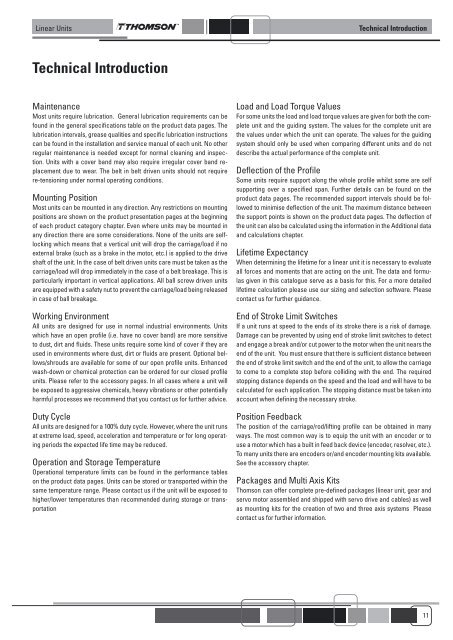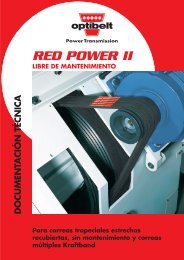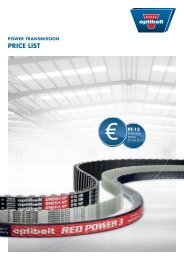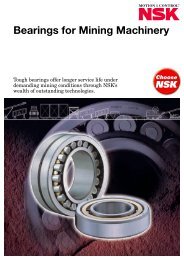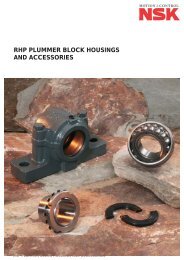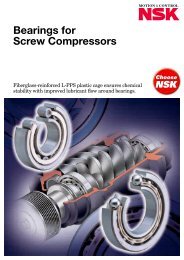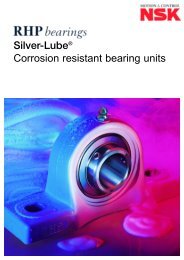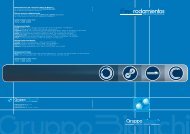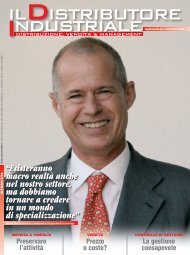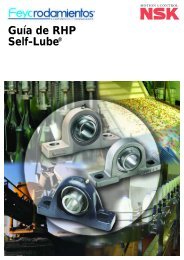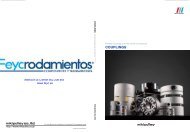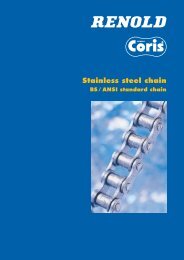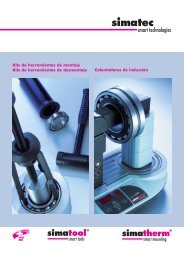Create successful ePaper yourself
Turn your PDF publications into a flip-book with our unique Google optimized e-Paper software.
Linear Units<br />
Technical Introduction<br />
Technical Introduction<br />
Maintenance<br />
Most units require lubrication. General lubrication requirements can be<br />
found in the general specifications table on the product data pages. The<br />
lubrication intervals, grease qualities and specific lubrication instructions<br />
can be found in the installation and service manual of each unit. No other<br />
regular maintenance is needed except for normal cleaning and inspection.<br />
Units with a cover band may also require irregular cover band replacement<br />
due to wear. The belt in belt driven units should not require<br />
re-tensioning under normal operating conditions.<br />
Mounting Position<br />
Most units can be mounted in any direction. Any restrictions on mounting<br />
positions are shown on the product presentation pages at the beginning<br />
of each product category chapter. Even where units may be mounted in<br />
any direction there are some considerations. None of the units are selflocking<br />
which means that a vertical unit will drop the carriage/load if no<br />
external brake (such as a brake in the motor, etc.) is applied to the drive<br />
shaft of the unit. In the case of belt driven units care must be taken as the<br />
carriage/load will drop immediately in the case of a belt breakage. This is<br />
particularly important in vertical applications. All ball screw driven units<br />
are equipped with a safety nut to prevent the carriage/load being released<br />
in case of ball breakage.<br />
Working Environment<br />
All units are designed for use in normal industrial environments. Units<br />
which have an open profile (i.e. have no cover band) are more sensitive<br />
to dust, dirt and fluids. These units require some kind of cover if they are<br />
used in environments where dust, dirt or fluids are present. Optional bellows/shrouds<br />
are available for some of our open profile units. Enhanced<br />
wash-down or chemical protection can be ordered for our closed profile<br />
units. Please refer to the accessory pages. In all cases where a unit will<br />
be exposed to aggressive chemicals, heavy vibrations or other potentially<br />
harmful processes we recommend that you contact us for further advice.<br />
Duty Cycle<br />
All units are designed for a 100% duty cycle. However, where the unit runs<br />
at extreme load, speed, acceleration and temperature or for long operating<br />
periods the expected life time may be reduced.<br />
Operation and Storage Temperature<br />
Operational temperature limits can be found in the performance tables<br />
on the product data pages. Units can be stored or transported within the<br />
same temperature range. Please contact us if the unit will be exposed to<br />
higher/lower temperatures than recommended during storage or transportation<br />
Load and Load Torque Values<br />
For some units the load and load torque values are given for both the complete<br />
unit and the guiding system. The values for the complete unit are<br />
the values under which the unit can operate. The values for the guiding<br />
system should only be used when comparing different units and do not<br />
describe the actual performance of the complete unit.<br />
Deflection of the Profile<br />
Some units require support along the whole profile whilst some are self<br />
supporting over a specified span. Further details can be found on the<br />
product data pages. The recommended support intervals should be followed<br />
to minimise deflection of the unit. The maximum distance between<br />
the support points is shown on the product data pages. The deflection of<br />
the unit can also be calculated using the information in the Additional data<br />
and calculations chapter.<br />
Lifetime Expectancy<br />
When determining the lifetime for a linear unit it is necessary to evaluate<br />
all forces and moments that are acting on the unit. The data and formulas<br />
given in this catalogue serve as a basis for this. For a more detailed<br />
lifetime calculation please use our sizing and selection software. Please<br />
contact us for further guidance.<br />
End of Stroke Limit Switches<br />
If a unit runs at speed to the ends of its stroke there is a risk of damage.<br />
Damage can be prevented by using end of stroke limit switches to detect<br />
and engage a break and/or cut power to the motor when the unit nears the<br />
end of the unit. You must ensure that there is sufficient distance between<br />
the end of stroke limit switch and the end of the unit, to allow the carriage<br />
to come to a complete stop before colliding with the end. The required<br />
stopping distance depends on the speed and the load and will have to be<br />
calculated for each application. The stopping distance must be taken into<br />
account when defining the necessary stroke.<br />
Position Feedback<br />
The position of the carriage/rod/lifting profile can be obtained in many<br />
ways. The most common way is to equip the unit with an encoder or to<br />
use a motor which has a built in feed back device (encoder, resolver, etc.).<br />
To many units there are encoders or/and encoder mounting kits available.<br />
See the accessory chapter.<br />
Packages and Multi Axis Kits<br />
Thomson can offer complete pre-defined packages (linear unit, gear and<br />
servo motor assembled and shipped with servo drive and cables) as well<br />
as mounting kits for the creation of two and three axis systems Please<br />
contact us for further information.<br />
11


